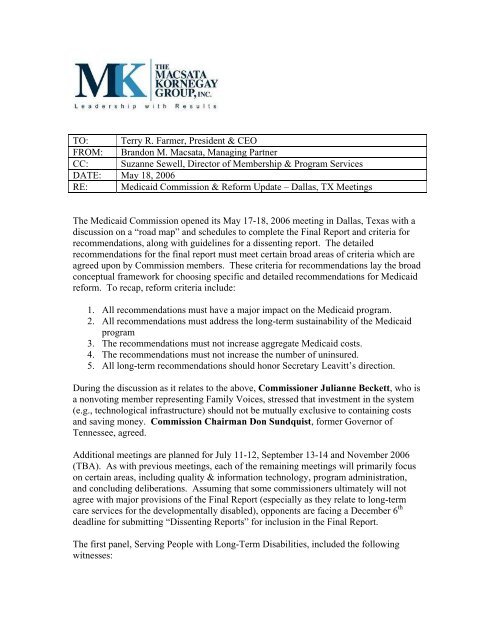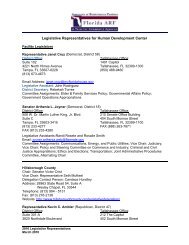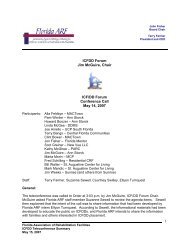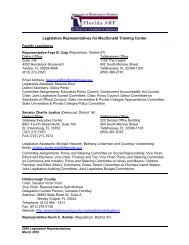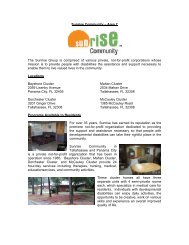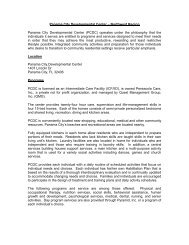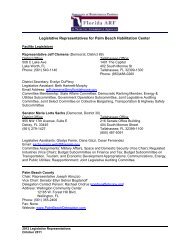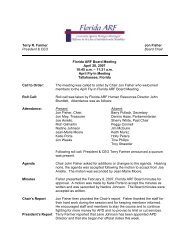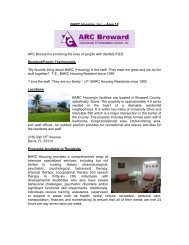TO: Terry R. Farmer, President & CEO FROM: Brandon ... - Florida ARF
TO: Terry R. Farmer, President & CEO FROM: Brandon ... - Florida ARF
TO: Terry R. Farmer, President & CEO FROM: Brandon ... - Florida ARF
- No tags were found...
Create successful ePaper yourself
Turn your PDF publications into a flip-book with our unique Google optimized e-Paper software.
He supported several strategies, including passing MiCASSA (H.R.910, S.401)legislation, implementing National Money Follows the Person policy and, implementingthe Supreme Court’s landmark Olmstead decision. Kafka’s proposal would level thenursing home entitlement by increasing choice for community services; integrate acuteand long-term services and supports; transition away from categorical funding tofunctional system based on need; defining health and safety that recognizes the dignity ofrisk and allows negotiated risk; promoting nurse delegation/assignment for healthmaintenance activities; quality measurement based on consumer satisfaction andcommunity integration evaluators; and coordinating support services and accessible,affordable, integrated housing.The final panel witness, Dr. David Jacox, <strong>President</strong> & <strong>CEO</strong> of Mosaic representing theLutheran Services of America presented a litany of reform positions. They included:o Position #1 – Persons with developmental disabilities deserve fair and appropriatesupports and services that are adequately and equitably funded. LSA’srecommendation called for adequate equitable reimbursement based on individualneeds.o Position #2 – Persons with developmental disabilities have various needs that donot always warrant costly and highly regulated supports. LSA’s recommendationencouraged more flexibility and less-burdensome regulations that promotecommunity living.o Position #3 – Millions of Americans with developmental disabilities are notreceiving any Medicaid funding supports. LSA’s recommendation said Medicaidpolicy should eliminate waiting lists and provide access to supports as needed.o Positions #4 – Persons with developmental disabilities should be enabled to livein their communities. LSA’s recommendation called for reforms that coordinatethe provision of skilled support staff and affordable and accessible housing andtransportation. This recommendation also addressed various aspects of workforceshortages and its adverse impact on people with developmental disabilities.Commissioner S. Anthony McCann posed the question about why the disabilitycommunity is so married to a fee-for-service or managed-care system, and opposed to avoucher payment system, whereby beneficiaries are given the money to direct their owncare. Kafka stated part of the problem related to lumping the “disability community” intoone subsection, because differing disabilities require differing supports and services. Heargued that capped vouchers would prove problematic for those persons who requireextensive supports.Commissioner John D. Kemp, a non-voting member representing the Disability ServiceProviders of America, stated that persons with disabilities can manage their own carewhen given the opportunity. He thanked Kafka for his remarks and encouraged thecommission to presume the opposite of the current way of thinking about disabledpopulations. Kemp stated reforms should be designed to reward good decisions, whichwill save money in the long run.
“The reductions required in subsection (a) of this section shall be redirected infiscal year 1997 to fund home and community-based services. For fiscal year1998 and thereafter, the reductions required in subsection (a) of this section shallbe redirected in that fiscal year to fund both home and community based servicesand any programs designed to reduce the number of nursing home beds. Anygeneral funds that are redirected but not spent during any fiscal year shall betransferred to the long-term care special administration fund which is herebycreated.”Vermont has looked at some creative approaches, including offering nursing homes to“right size” their facilities to 80 beds (rather than 100+ beds); increase rates to coverfixed costs and use some savings for additional slots. The approach has reformed thenursing home industry by eliminating empty beds and facilities losing $500,000 annually.As a result, Vermont’s percentage of elders residing in nursing homes has decreasedannually. According to Smith, goals for the Vermont proposal include:• Provide choice and equal access• Serve more people• Manage the costs of long-term care• Improve the system• Create a balanced system• PreventionThe Vermont waiver has shown, despite budget neutrality, only 7.28 percent annualgrowth, decreased nursing home bed utilization (and costs) and increased communityplacements. As a result, waiting lists have also been significantly reduced.When questioned by Commissioner Gail C. Christopher, DN, Vice-<strong>President</strong> of theOffice of Health, Women and Families, Joint Center for Political and Economic Studies,about being comfortable with budget neutrality, Smith said that he was very“comfortable” with the budget neutrality requirement because it is yielding a sustainablelevel of annual growth (7.28%). Smith stated other states would probably be envious ofVermont’s position.Commissioner McCann questioned whether the Vermont approach could be replicatedacross the country, taking into consideration various “cultural” norms of the state thatdifferentiate it. Smith disagreed and felt that it could easily provide a workable templatefor other states.Commissioner Kemp asked Smith for his thoughts about categorizing persons byfunctional capabilities, or lack thereof, and rewarding good choices. Smith respondedthat Vermont has not witnessed a “woodworking” effect under the waiver, yet it offersgenerous choices for care. Smith said he supports getting away from categorical fundingsilos each with different regulations, funding streams, etc.
“What is the difference between a 59 year old with a disability versus a 60 year olddisability?” questioned Smith. “Nothing, other than they fall into a different age group.”He also agreed with Kemp that systems should be put into place to offer casemanagement to assist with making better health related decisions. He categorized it asoversight assistance rather than managed care. He visualized an important aspect of cash& counseling demonstration projects as rewarding good health decisions.Smith made several recommendations for the Medicaid Commission to consider:• Allow equal entitlement to nursing and home care;• Allow states cap overall entitlement;• Require commitment to maintenance of effort;• Allow maximum consumer direction & control;• Allow Medicare & Medicaid to purchase more assistive technology; and• Allow states to make nursing home services only if and when community basedservices failMr. Chuck Milligan, JD, MPH, consultant to the Medicaid Commission, profiled ‘DualEligibles’ in preparation for the afternoon’s last two sessions. Dual eligiblessimultaneously receive benefits from the Medicare and Medicaid programs, and havemore functional impairments than other Medicare beneficiaries. On average, dualeligbles cost twice as much as other Medicare beneficiaries and represent 14 percent ofthe Medicaid’s enrollment, yet account for 40 percent of all Medicaid spending. Most ofMedicaid’s spending on dual eligibles is on long-term care services. Two-thirds of dualeligibles are eligible because of age (4.9 million beneficiaries); one-third because ofdisability (2.5 million beneficiaries).Milligan discussed why Medicaid supplements Medicare. He summarized that dualeligibles generally are below the poverty line. In addition, Medicare does not offer acomprehensive benefit package (e.g. no coverage for most long-term care services),Medicare has a premium of $78 per month for Part B, and many Medicare-coveredservices have a cost-sharing component. Milligan also stressed that the Medicareprogram’s short-term inpatient rehabilitative benefit (65.4% of all nursing homeadmissions come from a hospital) often leads to long-term Medicaid services becausebeneficiaries receive poor case management. .The afternoon’s last two sessions highlighted best practices for dual eligibles.“Best Practices for Duals: Provider Information” included two witnesses, including:• John Mach, Jr., MD, <strong>CEO</strong>, Evercare• Robert J. Master, MD, <strong>President</strong>, Commonwealth Care AllianceMr. John Mach, Jr., MD, <strong>CEO</strong> of Evercare testified on how chronic illness is driving“health care crisis” in the United States, need for care management, integrating Medicareand Medicaid and, Medicaid reforms to encourage integration.
Mach shared some key data on the impact of chronic illness on Medicaid. Eighty-seven(87) percent of Medicare & Medicaid dual eligibles have one (1) or more chronicconditions and sixty-three (63) percent of dual eligibles have one or more limitation inactivity limitations.According to Mach, Medicaid’s current care system is designed more for acute care. Thelong-term care system is fragmented among numerous providers, poorly transitionpatients across care settings and offers lack of systematic approach to prevention andearly identification of change. Reforms should encompass a full continuum of placementoptions, thereby providing choices for consumers, improves independence with moneyfollowing the person and, fosters Olmstead compliance. Integrated LTC systems inseveral states have produced improved consumer outcomes, including <strong>Florida</strong>, Texas,Arizona, Wisconsin, and Minnesota. For example, <strong>Florida</strong>’s Nursing Home DiversionProgram (NH) cares for clients with higher impairment in the community, reports fewerunmet needs and higher satisfaction with case management.Mach also identified multiple obstacles to reform.“The impact of all of these obstacles is that only 2-3% elderly and disabled Medicaidbeneficiaries are in integrated plans,” summarized Mach. “We need to find a way tobring these models to a scale which will make a true difference in program outcomes.”His proposal called for creation of coordinated, integrated LTC plans without a waiverthrough a new state plan option. It also incorporated aligning Medicare and Medicaid inareas of marketing, grievances, enrollment and quality assurance. Finally, it encouragedrebates to the state half of the federal saving in the Medicare Advantage bid for each dualin an integrated plan.Mr. Robert J. Master, MD, <strong>President</strong>, Commonwealth Care Alliance, followed withadditional information on disabled population characteristics that are cost-drivers. Hispresentation focused on the lessons learned from the Commonwealth of Massachusetts.Master provided three individual cases of persons with different impairments to emphasishis point.He shared element of a successful care model for special needs patients and systemcapacity, which include:• Meaningful consumer involvement in care management and care design;• Specialized primary care network;• Multidisciplinary tram approach to care;• Transfer of clinical decision making to the home;• 24/7 personalized continuity of care in all settings at all times;• Fully organized, hospital and institutional alternative networks;• Primary care team empowerment to order/authorize all needed services;• Full integration of Medical, Behavioral Health and Long Term Care Services; and• Electronic medical record and state of the art data support.
His presentation summarized that redesigning prepaid care systems can yield enormouspotential to improve care and manage costs for medically complex, vulnerable andexpensive Medicaid and dual eligibles. The existing programs have all demonstrated thatthey work, leaving the question more to how best t scale it within various policyproposals (e.g., risk adjusted premiums, programmatic integration).Master stated that over 90 percent of hospitalizations are acute in nature, lending to beingavoided using better preventive strategies. Both witnesses stressed the importance ofadvanced care planning.Finally, Commissioners heard from three experts during “Best Practices for Duals: StateInnovation.” Witnesses included:• Pamela Coleman, Director, Medicaid/CHIP Health Plan Operations, TexasSTAR+PLUS• Kathleen Shure, Director, Office of Managed Care, New YorkMs. Pamela Coleman, Director, Medicaid/CHIP Health Plan Operations, TexasSTAR+PLUS talked about coordination of care models. The program, which started as apilot in 1998 in Harris County, Texas, is a risk-based, capitated managed care system. Itintegrates Medicaid funding and service delivery of long term and acute care, servingapproximately 60,000 aged and disabled not residing in nursing homes.The program was implemented because aged and disabled beneficiaries represented 20percent of the Medicaid population in 2004, yet represented over 60 percent of costs. It isdesigned to better manage their acute and long-term care needs. The LTC servicescovered include personal assistance, day activity and health, adaptive aids, adult fosterhomes, assisted living, medical supplies, home modifications, respite care, therapies, andemergency response.With respect to controlling costs, a review study completed in July 2003 showed that thetraditional Primary Care Case Management (PCCM) model was $13,160 per month perclient, versus $3,226 per month per client in STAR+PLUS. The biggest difference wasunder inpatient and ER use in the STAR+PLUS (approximately 40 percent difference).Coleman indicated that expansion of mandatory Medicaid managed care could yield$145.8 million in total savings (Federal and Texas).Coleman’s testimony showed that cost savings result from managing care by:• Early identification and treatment of health problems.• Promoting wellness and healthy lifestyles.• Avoiding higher cost services and products when lower-cost, clinicallyappropriate services can be rendered.• Coordinating care effectively and reducing duplication of service.
Texas was preparing to expand the program, but ran into barriers with the federallyimposedUpper-Payment Limit to public hospitals. With that in mind, Vice-ChairmanKing asked whether it was Ms. Coleman’s recommendation to do away with theMedicaid law prohibiting hospitals from receiving UPL if they are paid by a capitatedHMO. She responded, “Yes!”Ms. Kathleen Shure, Director of New York’s Department of Health, Office of ManagedCare, discussed integration care models. New York’s dual eligible initiative – known asMedicaid Advantage – began development in 2003. The program’s initial focus was onenrollees who were “aging” into Medicare, but scope quickly broadened for severalreasons.Day one concluded with Commissioners engaging in a discussion about what they hadheard throughout the morning and afternoon. Upon hearing numerous comments andsuggestions, Commissioner Kemp conceptualized the day’s events using the followingthree assumptions:1. For Long-Term Support Services, elders and persons with disabilities should beencouraged by policy to stay in their homes first, then in their communities andthen in the least restrictive or most integrated setting appropriate to their needs.2. That elders and persons with disabilities can make good decisions whenempowered through self-determination and directing their own supports andservices.3. That Long-Term Support Services be funded based on functional limitations andneeds, and not by categorical disabilities or health conditions.Upon hearing Kemp’s remarks, Chairman Sundquist asked Kemp to lead the nextmorning’s discussion about next steps and possible reform recommendations.On Thursday, May 18 th , Commissioners opened by listening to the remarks from one lastpanel. The “Reform Proposal Panel” included:• Lisa Alexcih, Vice-<strong>President</strong>, The Lewin Group• Martha Roherty, Director of the Center for Workers with Disabilities, NationalAssociation of State Medical Directors• Dennis Smith, Director, Center for Medicaid & State Operations, Centers forMedicare & Medicaid ServicesMs. Lisa Alecxih, Vice-<strong>President</strong> of The Lewin Group, provided an excellent summaryon “A Dozen Long Term Care Myths and Their Implications for Medicaid Reform.”Alecxih’s myths related to financing of long-term care, role of Medicaid, eligibilitystandards, possibilities for the future, health promotion and quality.1. Myth #1 – Medicaid pays the vast majority of LTC costs.
Medicaid actually pays one-half of LTC, but out-of-pocket underestimated and informalcosts are not counted. The economic value of informal care estimated at $257 billionannually.2. Myth #2 – Most people who require supports as a result of a disability live ininstitution.More Medicaid spending for institutions, but more people needing support live in thecommunity. Among non-elderly with disabilities, 95%+ live in the community.3. Myth #3 – Medicaid does not pay for housing.Medicaid pays for nursing facility room and board costs. Medicaid does not pay forcommunity-based housing.4. Myth #4 – States have made consistent progress in shifting to HCBS acrossdisability populations.There has been greater progress “rebalancing” LTC for MR/DD than aged and disabled.The proportion of Medicaid LTC spending on HCBS for MR/DD nearly doubled over thepast decade while aged & disabled grew at half that rate.5. Myth #5 – Many beneficiaries of Medicaid LTC qualify because they divestedtheir assets.Empirical evidence finds few Medicaid recipients use trusts or give away assets. Littleempirical evidence supports claims that large numbers of elderly plan their estates to gainaccess to Medicaid nursing home coverage.6. Myth #6 – People on Medicaid contribute little to the cost of their care.Medicaid nursing facility residents contribute nearly all of their income with theexception of a personal needs allowance, typically $30 to $100/month. Many states alsorequire cost-sharing for the HCBS waiver. Medicaid rules also protect the primaryresidence while the individual or their spouse is alive.7. Myth #7 – Increasing HCBS will reduce Medicaid spending.As a result of demographic changes, Medicaid LTC spending will invariably increase.Expanding HCBS can increase the number of people served and could reduce the rate ofincrease.8. Myth #8 – Baby Boomers recognize the need to plan for LTC in their future.Few Americans plan ahead for LTC needs. Less than 10 percent of those age 50+ ownlong-term care insurance policy.
9. Myth #9 – Individuals can save enough to cover their LTC costs.While most could save enough money, over 25 percent would face expenses over$100,000. In 2000, median net worth among elderly was $110,000 but only $25,000excluding home equity.10. Myth #10 – LTC insurance & reverse mortgages can solve the financing dilemma.LTC insurance & reverse mortgage can increase the LTC options for a subset ofAmericans, but these private sources are not “a silver bullet.”Alecxih presented her top five Medicaid LTC recommendations:• Eliminate barriers and actively encourage Medicare-Medicaid integration• Make HCBS an entitlement with equal access as nursing home care, which meansactive intervention into critical pathways• Enhance supports to family and friends as caregivers• Effective, consistent, person-centered service coordination that goes beyondmedical or LTC specific but does both plan health promotion, housing,transportation and other that enables productive community living• Institute individualized budgets, consumer direction, and cash & counseling.Ms. Martha Roherty, Director of the Center for Workers with Disabilities, NationalAssociation of State Medical Directors, discussed various state-level initiatives. Rohertystated that the position of the NASMD is the same as the National GovernorsAssociation. She praised several provisions of the Deficit Reduction Act that aredesigned to grant greater flexibility to the states. She recommended that the Commissiontake a closer look at transferring LTC benefits and financing to the Medicare program.Mr. Dennis Smith, Director, Center for Medicaid & State Operations, Centers forMedicare & Medicaid Services, concluded the panel with his presentation. In general,Smith shared his hopes for more private market initiatives to help alleviate the strain onthe public financing system. Specifically, he stated the DRA took a “giant leap forward”to level the playing field between HCBS services and institutional care.He recommended that the Commission take a look at the way state plans are structured,dividing the benefits packages into acute and LTC with different eligibility standards. Hecited examples where states eliminated some of the asset tests for certain benefits.Smith stated that CMS funds over 70 different services under the HCBS heading,including delivery of meals to the home, and personal care. But he cautioned thatexpansion should be weighed against the possible woodworking-effect. While heacknowledged Medicaid has stepped up in many instances to fill the gap, he stressed thatif other sectors were doing their part the pressure on Medicaid would be alleviated.
The panel’s presentations led the Commission to engage in a discussion over the costshiftingrecommendations, as well as modernizing the Medicaid program. The lion’sshare of the questions was directed to Dennis Smith.One commissioner asked about pending “Wal-Mart” bills pending before statelegislatures and whether such steps would help. Smith responded it is always interestingto gauge what the market will bear, and spent some time assessing the labor pool – citingthat New York State has become so competitive that hospitals are flying nurses into thestate. He followed by stating that individualized budgets and cash & counseling wouldhelp to address the problems surrounding the labor pool.In addition, Smith praised the DRA, stating that it removed many of the barriers thatstates faced when trying to implement meaningful reforms. “State flexibility has addedpeople to Medicaid,” he said.Furthermore, he summarized that DRA is good because it involves beneficiaries inmaking decisions, pays providers better and spreads the risk more equitably. Referring tothe waiver process, Smith summarized: “Twenty years later, it is time to move away fromstates having to come to Washington.”There was some additional review of the confusion that exists with so many programs,standards and regulations. One of the points that were raised continually throughout thetwo days of meetings is better coordinating services, mainly Medicare and Medicaid.Commissioner Troy Justesen, PhD, Deputy Assistant Secretary of the Office of SpecialEducation and Rehabilitative Services, Department of Education, stated that theCommission would be missing a major opportunity to remove federal bureaucracy if itdid not recommend consolidating many of the 200+ federal agencies overseeing supportsand services to persons with disabilities. “It has a major impact on cost saving,dramatically,” Justesen stated.Commissioner Robert Helms, PhD, Resident Scholar in Health Policy Studies at theAmerican Enterprise Institute asked if the simplest approach would be to convince theCongress to federalize the system, or block grant approach.The three panelists replied that they would favor simplifying the regulatory process, andRoherty stated her organization would not favor block grants. Smith did not address theblock grant aspect of Helms’s question.Vice-Chairman King questioned Roherty why she was so quick to say no to block grants,referring to the successful approach that was implemented with welfare reform Shestated that it is a long-standing position of the states, as well as block grants wouldremove the entitlement protection. Commissioner McCann stated from a stateperspective why block grants do not bold well for the states. There was some additionalconversation about the Medicaid entitlement, as well as some private market options.
Next, Commission Chairman Sundquist called upon Commissioner Kemp to lead adiscussion on long-term care and community inclusion using the three presumptions thathe outlined the previous day. Kemp started by commenting on the Medicaid statute(SEC. 1901. 42 U.S.C. 1396), which includes “rehabilitation and other services to helpsuch families and individuals attain or retain capability for independence or self-care.”On the question of consolidation of all disability programs, Kemp cautioned that thereneeded a balance because the disability community has worked so hard to become moreintegrated over the years. Yet, he recognized that many of the programs designed toprovide supports and services are expensive and also poorly understood, and that greatercoordination (i.e. consolidation) might prove useful.While Commissioner Justesen agreed, he continued to express concern that differentpolicies, inconsistent policy decisions and varying implementation and should lead to anindependent review of whether such programs are housed in the appropriate place.The Medicaid Commission meeting concluded with its standard public comment period.Over thirty organizations submitted comment.The next meeting of the Medicaid Commission will take place in Washington, DC onJuly 11-12, 2006. In the meantime, DSPA members should consider making the trip toWashington to present during the public comment period. We will keep you updated onthe July meetings as more information becomes available.


